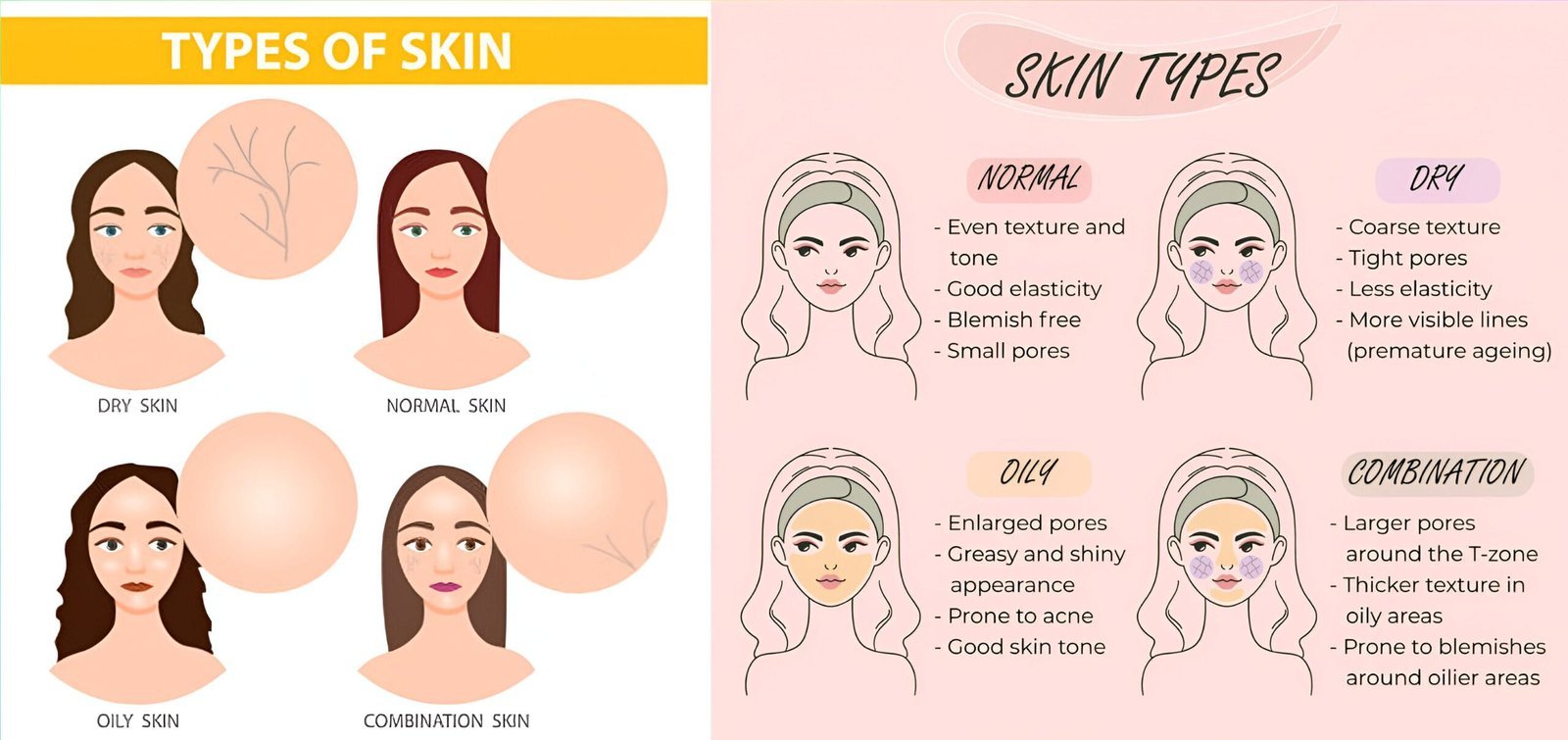Introduction to Skin Types Understanding your skin type is the foundation of effective skincare. While it may seem trivial, knowing your skin type he
Introduction to Skin Types
Understanding your skin type is the foundation of effective skincare. While it may seem trivial, knowing your skin type helps you choose products and routines that bring out the best in your skin’s natural beauty. It prevents over-drying, reduces the chance of breakouts, and ensures that your skin stays healthy and radiant over time. From dry and sensitive skin to oily and acne-prone skin, each type requires a specific approach, and your journey to great skin begins with finding your unique type.
Importance of Knowing Your Skin Type
Your skin type is more than just a label—it’s a guideline for how your skin reacts to environmental factors, products, and even changes in lifestyle. For instance, those with oily skin may be prone to more acne breakouts, while individuals with dry skin might experience tightness and rough patches. Knowing your skin type:
- Prevents Irritation: Using products designed for a different skin type can lead to irritation and sensitivity.
- Maximizes Product Effectiveness: Tailoring products to your skin type improves overall results.
- Protects Skin Health: Following a routine suited to your skin type prevents long-term damage and keeps your skin looking youthful.
Factors Affecting Skin Type
While genetics play a key role in determining your skin type, other factors like climate, diet, and lifestyle choices can also affect it. Seasonal changes may make your skin drier or oilier, and your skin’s needs can shift with age or stress levels. Hormonal fluctuations, hydration levels, and diet are other factors that can cause temporary or permanent changes to your skin type.

Identifying Your Skin Type
Before jumping into any skincare routine, take time to understand your skin’s unique characteristics. Observing how your skin reacts throughout the day, especially after cleansing, can reveal important clues.
Common Signs and Features
- Normal Skin: Balanced moisture and sebum production, few blemishes, even texture.
- Oily Skin: Shiny appearance, enlarged pores, frequent acne or blackheads.
- Dry Skin: Flaky patches, tight or rough texture, small pores.
- Combination Skin: Oily in the T-zone (forehead, nose, chin) and dry in other areas.
- Sensitive Skin: Prone to redness, irritation, and reactions to products.
Simple Tests for Determining Skin Type
To determine your skin type at home, try these easy methods:
- The Bare-Face Test: Wash your face with a gentle cleanser and pat it dry. Wait an hour, and then observe your skin. If it’s shiny all over, you likely have oily skin. If it feels tight and flaky, you might have dry skin. A mix of these characteristics often points to combination skin.
- The Blotting Sheet Test: Gently press a blotting sheet to different areas of your face. If the sheet picks up oil only from the T-zone, you may have combination skin. If it’s covered in oil, you have oily skin, and if it remains dry, you likely have dry skin.
Normal Skin
Normal skin, often referred to as “balanced,” tends to be neither too oily nor too dry. It’s typically well-moisturized, resilient, and experiences minimal breakouts or flakiness. Though often regarded as the “ideal” skin type, it still requires care and protection to maintain its balanced nature.
Characteristics of Normal Skin
- Even tone and smooth texture
- Minimal pores and few blemishes
- Healthy, radiant appearance without excessive shine
- No significant dry patches or sensitivity
Ideal Skincare Routine for Normal Skin
- Gentle Cleanser: Use a mild cleanser twice daily to maintain skin balance.
- Lightweight Moisturizer: Hydrate without making the skin greasy. Look for ingredients like hyaluronic acid and glycerin.
- SPF Protection: Protect your skin from sun damage daily with at least SPF 30.
- Exfoliation: Once or twice a week, use a gentle exfoliant to keep skin smooth.
- Night Serum: Consider using a light serum at night for added nourishment.
While normal skin is relatively low-maintenance, consistent care is still crucial. Avoid harsh products and ensure you’re staying hydrated to keep this balanced skin type healthy.
Oily Skin
Oily skin is known for its tendency to produce excess sebum, which can lead to a shiny appearance, especially in the T-zone. While oily skin is prone to clogged pores and acne, it is also known for aging more slowly due to natural moisture retention.
Characteristics of Oily Skin
- Shine and excess oil on the forehead, nose, and chin
- Enlarged pores, particularly around the T-zone
- Prone to blackheads, pimples, and whiteheads
- Makeup often “slides off” during the day due to excess oil
Causes of Excess Oil Production
Several factors can contribute to oily skin, including:
- Genetics: If your parents had oily skin, you’re more likely to experience it as well.
- Hormones: Hormonal fluctuations, especially during puberty, menstruation, or pregnancy, can increase oil production.
- Climate: Humid or hot climates often make skin oilier.
Best Skincare Tips for Oily Skin
- Foaming Cleanser: Use a gentle foaming cleanser twice daily to remove excess oil and prevent clogged pores.
- Lightweight Moisturizer: Even oily skin needs hydration. Opt for a non-comedogenic, oil-free moisturizer.
- Oil-Control Serum: Consider serums with niacinamide or salicylic acid to regulate oil production.
- Clay Masks: Use a clay mask once or twice a week to help absorb excess oil.
- SPF: Look for a mattifying sunscreen to prevent shine and protect from sun damage.
With a targeted approach, you can manage oily skin effectively and reduce the appearance of blemishes and shine.
Dry Skin
Dry skin often feels tight, rough, or flaky and can be more susceptible to fine lines and wrinkles. This skin type lacks sufficient oil to keep it well-lubricated, leading to a dull appearance and discomfort, especially in cold or dry weather.
Characteristics of Dry Skin
- Flaky patches and a rough texture
- Small, nearly invisible pores
- Tight feeling, especially after washing
- Prone to fine lines and dullness
Common Causes of Dryness
Dry skin can be influenced by a variety of factors, such as:
- Environmental Conditions: Cold or dry weather can strip the skin of moisture.
- Hot Showers: Prolonged exposure to hot water can remove natural oils.
- Aging: As we age, our skin naturally produces less oil.
Effective Treatment for Dry Skin
- Creamy Cleanser: Use a hydrating, cream-based cleanser to clean without stripping natural oils.
- Rich Moisturizer: Choose a moisturizer with ceramides and hyaluronic acid to lock in moisture.
- Hydrating Serums: Use serums with glycerin or aloe vera for an added layer of hydration.
- Humidifier: Keep a humidifier in your room to prevent dryness, especially during winter.
- SPF Protection: Moisturizing sunscreens help shield dry skin from UV damage.
With the right products, dry skin can become more resilient, hydrated, and soft.
Combination Skin
Combination skin is a blend of oily and dry characteristics, typically with an oily T-zone (forehead, nose, and chin) and drier areas around the cheeks. This skin type can be challenging to manage due to its varying needs.
Characteristics of Combination Skin
- Oily T-zone with dry or normal cheeks
- Enlarged pores in the T-zone
- Prone to breakouts in the oily areas while other parts may feel tight
Managing Different Areas
For combination skin, the goal is to balance moisture without over-drying or adding excess oil. Treating the different areas based on their needs can help you manage combination skin effectively.
Balancing Skincare for Combination Skin
- Dual Cleanser: Use a gentle foaming cleanser for the T-zone and a creamier option for drier areas.
- Balancing Moisturizer: Opt for a lightweight, non-greasy moisturizer that hydrates without adding too much oil.
- Targeted Treatments: Use oil-control products for the T-zone and hydrating serums for dry patches.
- Weekly Exfoliation: Exfoliate the T-zone more frequently to keep pores clear while exfoliating dry areas less often.
- SPF Protection: Apply a lightweight sunscreen to protect all areas without causing excess oil.
By balancing the needs of each area, combination skin can be well-managed for a more even, healthy appearance.
